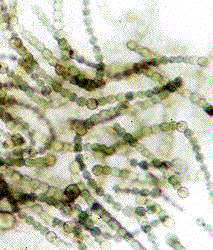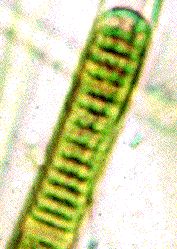







Cyanobacteria are among the easiest microfossils to recognize. They are larger than other bacteria, and morphologies in the group have remained much the same for billions of years.
Like other bacteria, cyanobacteria have no nucleus or internal membrane systems. In many species, however, the external membrane has been folded to increase total surface area. The "packets" created in the cell membrane by these foldings are the surfaces across which the chemical reactions of photosynthesis take place.
All cyanobacteria are unicellular, though many grow in colonies or filaments, often surrounded by a gelatinous or mucilaginous sheath. Nostoc, pictured below at left, may produce spherical colonies as much as three or four centimeters in diameter. These are large enough to be mistaken for amphibian eggs. Fossilized cyanobacterial mounds are called stromatolites.


Despite the fact that they lack flagella, many cyanobacteria are capable of moving about. Oscillatoria, pictured above at right, gets its name from the "swaying" motion of its filaments when observed under the microscope. No one has yet determined how these filaments are able to do this.


